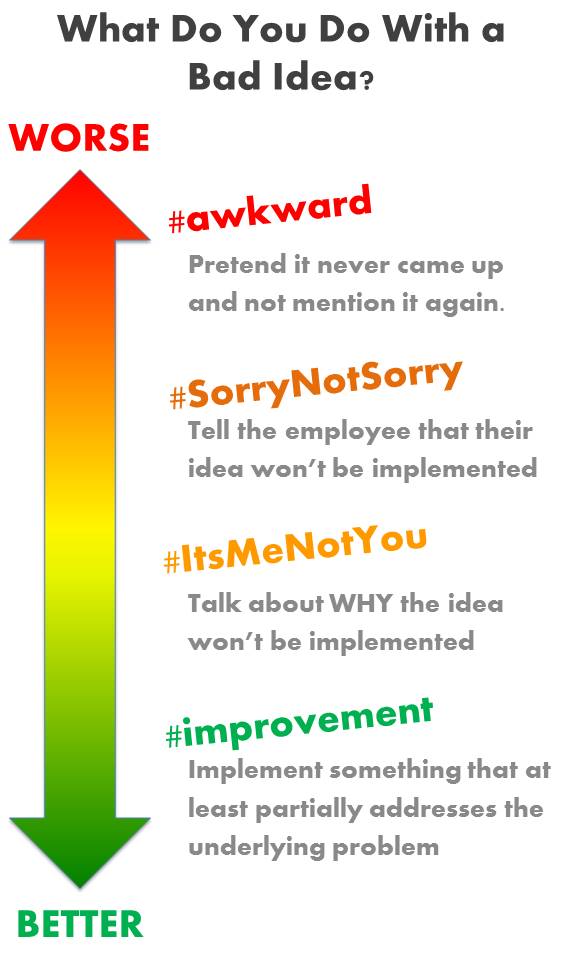 If you’re leading the continuous improvement efforts for your organization (or any part of it), at some point you’ve probably found yourself busier than a one legged cat in a sandbox as you try to sift through them. At that point, it’s only natural to want to weed through those ideas and toss out the ones that aren’t going to result in an improvement for the organization. That way, you can focus your efforts on the good ideas that you actually want to see implemented - and your organization will improve more. Right?
If you’re leading the continuous improvement efforts for your organization (or any part of it), at some point you’ve probably found yourself busier than a one legged cat in a sandbox as you try to sift through them. At that point, it’s only natural to want to weed through those ideas and toss out the ones that aren’t going to result in an improvement for the organization. That way, you can focus your efforts on the good ideas that you actually want to see implemented - and your organization will improve more. Right?
WRONG.
Even though you might have the power to throw away (or delete, or ignore) the opportunities for improvement that your staff find, you should never do it. Well, I won’t say never; it’s possible that your staff could submit an idea that contains privileged information, or is otherwise inappropriate. In that case, you have the green light to get rid of it as quickly as you can.
That’s the only reason you should ever completely disregard an idea for improvement.
You should NEVER disregard an idea if your reason is that:
-
It's a bad idea
This is an opportunity for additional coaching. People submit ideas because they feel there are problems to fix. If they originally came up with a bad solution to the problem, you should help them find a better solution - or connect them with someone else who can. -
It can't be feasibly done
Sometimes people submit pipe dreams when you ask for improvement ideas. Even if you agree that it's a good idea, you can't do anything about it. This is an opportunity to engage with the employee to see if a more practical improvement can be made. Even if it can't, discussing the idea and leaving it in your continuous improvement software (or spreadsheet, or whatever tool you use to create a record of that work) and leaving it in the system ensures a record that the idea was submitted and tells people in the future why it wasn't implemented. -
It's already been done before
When someone identifies an opportunity for improvement that's already part of your standard operating procedure, they've revealed a hole in training or communication. Letting someone know that their idea has already been implemented fills that gap, and provides you with the opportunity to share that information with others, too, in case they also weren't aware of the SOP. Recording the opportunity for improvement makes the SOP available to others in the future, and further engages the employee in continuous improvement. -
Nothing needs to be done
If someone submits an idea and you REALLY don't think anything needs to be done, you should communicate with that employee to let them know why. By resolving the opportunity and logging it in your database, there's a reference point for others who may have the same idea. This should very rarely be cause for not acting on opportunities for improvement, though, as most ideas will have some value to the company.

Benefits of addressing every improvement idea - even ones that won’t be implemented:
-
If someone else has the same idea, they won't have to resubmit it (and you won't have to keep deleting it).
-
The person who submitted the idea gets credit for being engaged in continuous improvement, even if the it isn't implemented.
-
You have new opportunities to engage with staff and coach them in identifying opportunities for improvement that will result in a change.
-
By responding to improvement ideas rather than deleting them, employees will see that you value their input, even if you don't agree with it.
-
You can track the percentage of ideas that actually result in a change, which is a good measure of the health of your culture of continuous improvement.
“But, Becca, I don’t have time to implement all of their ideas!”
Ahhhh, you see, that’s the beauty of engaging your employees in continuous improvement. The thing is, you don’t have to implement all of their ideas - you just have to empower them to implement the ideas themselves! Your job as a leader of continuous improvement is to supervise their improvement work and provide coaching as needed so that they get continuously better at it. There are lots of things you can do to empower them to make positive changes on their own - things like ensuring that they have adequate time to improve their work (not just to do it), providing them with a way to collaborate with others, recognizing people for the efforts.
Download this free eBook about leadership behaviors that support a culture of continuous improvement to see what else you can do to take a load off your shoulders and empower your team to help!



Add a Comment